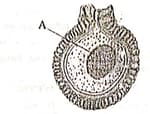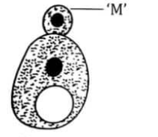HARD
Earn 100
Differentiate between budding in yeast and budding in Hydra.
Important Questions on Reproduction in Organisms
MEDIUM
HARD
Which structure is formed from the “A” part of the given diagram?

EASY
EASY
Match the following
| List-I | List-II | ||
| (A) | Longitudinal binary fission | (I) | Paramoecium |
| (B) | Transverse binary fission | (II) | Amoeba |
| (C) | Sporogony | (III) | Pleurobrachia |
| (D) | Sporulation | (IV) | Plasmodium |
| (V) | Euglena |
EASY
MEDIUM
EASY
Mention the asexual reproductive structures of the following:
Sponges
EASY
EASY
Identify the asexual reproductive structure in the following diagram:

EASY
EASY
What is artificial method of vegetative propagation?
Budding
EASY
EASY
EASY
EASY
MEDIUM
MEDIUM
Which option shows correctly matched pairs for Column I and Column II?
| Column I | Column II | ||
| P) | Planaria | i) | Fragmentation |
| Q) | Sycon | ii) | Fission |
| R) | Star-fish | iii) | Spore formation |
| S) | Plasmodium | iv) | Budding |
EASY
What is artificial method of vegetative propagation?
Cutting
MEDIUM
Lateral branches arise from the basal and underground part of the main stem
Branches bent and grow downwards
Branches grow obliquely upwards
Lateral branches arise from the base of the main axis and are aerial

